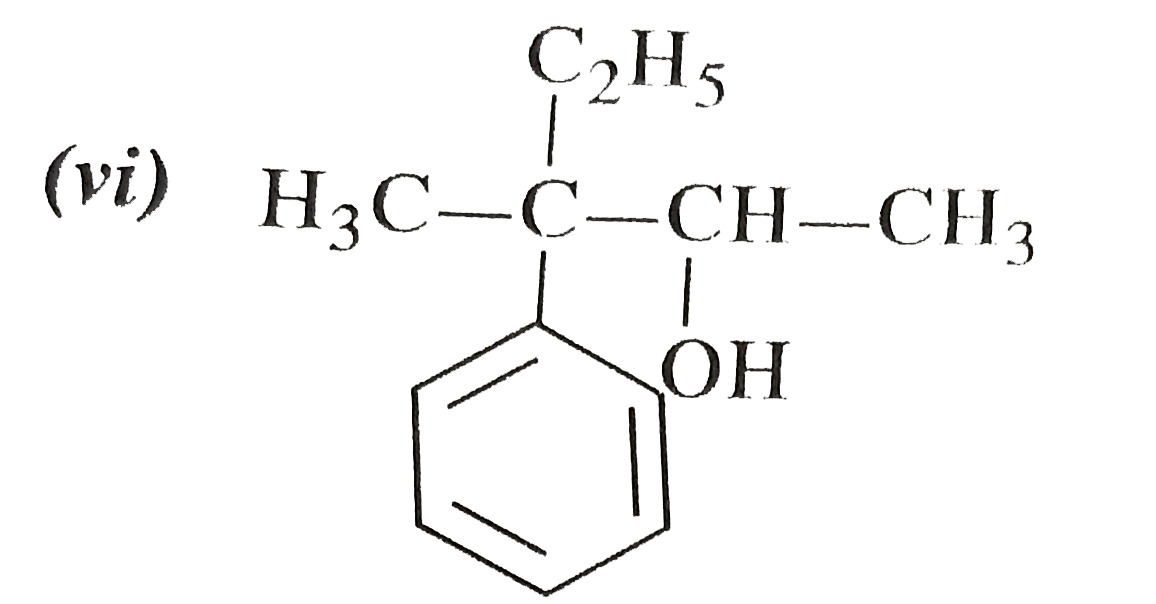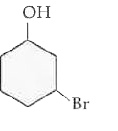What are X, Y, Z in the following reactions ?
OH |CH3−CH−CH3x−−→CH3−CH=CH2+H2O
CH3−CH2−OHY−−→CH2=CH2+H2O
CH3 |CH3−C−OHZ−−→CH3−C=CH2+H2O | | CH3 CH3Solution in Telugu
X Y ZH2SO4,443K85%H3PO4,440K20%H3PO4,358K
X Y Z85%H3PO4,440KH2SO4,443K20%H3PO4,358K
X Y Z20%H3PO4,358KH2SO4,443K85%H3PO4,440K
X Y ZH2SO4,443K20%H3PO4,358K85%H3PO4,440K
The correct Answer is:B
OH |CH3−CH−CH385%H3PO4(X)−−−−−−−−−→440KCH3−CH=CH2+H2O
CH3CH2OHH2SO4(Y)−−−−−−→443KCH2=CH2+H2O
CH3 |CH3−C−OH20%H3PO2(Z)−−−−−−−−−→358KCH3−C=CH2+H2O | | CH3 CH3
These reactions are known as dehydration reaction where H3PO4 and H2S4 are dehydrating agents. Ethanol undergo dehydration by heating with conc. H2SO4 at 443 K whereas 2∘ alcohols by 85% H2PO4 at 440 K and 3∘ alcohols by 20% H3PO4 at 358 K.
Topper's Solved these Questions
- BOOK - TS EAMCET PREVIOUS YEAR PAPERSCHAPTER - QUESTION PAPER 2019EXERCISE - Chemistry80videos
QUESTION PAPER 2019
- BOOK - TS EAMCET PREVIOUS YEAR PAPERSCHAPTER - TS EAMCET ENGINEERING ENTRANCE EXAM QUESTION PAPER (2018)EXERCISE - CHEMISTRY40videos
TS EAMCET ENGINEERING ENTRANCE EXAM QUESTION PAPER (2018)
Similar Questions
The maximum number of electrons that can have the set of quantum numbers, n=4,ml=0 and ms=12 is
02:03View SolutionIn a photoelectric effect experiment, the kinetic energy of an emitted electron is 1.986×10−19J , when a radiation of frequency 1.0×1015s−1 hits the metal. What is the threshold frequency of the metal (in s−1 )?(Planck's constant =6.62×10−34 Js)
02:07View SolutionH_(3)C-overset(O)overset(||)(C)-CH_(2)CH_(2)CO_(2)CH_(3) to H_(3)C-overset(OH)overset(||)(CH)-CH_(2)CH_(2)CH_(2)OH can be effected using:
01:27View SolutionCH_(3)-underset(CH_(3))underset(|)(CH)-CH=CH-CH_(2)-overset(O)overset(||)(C)-OH
03:50View SolutionIn the reaction given below, the product would be : CH_(3)-CH=CH-CH_(3)overset(H_(3)O^(+))(to)CH_(3)-CH_(2)-overset(OH)overset(|)(C)H-CH_(3)
View SolutionH_(3)C-overset(O)overset(||)(C)-CH_(2)CH_(2)CO_(2)CH_(3) to H_(3)C-overset(OH)overset(||)(CH)-CH_(2)CH_(2)CH_(2)OH can be effected using:
04:58View SolutionGive the IUPAC names of the following compounds:
(i)C6H5−CH2−CH2−OH (ii)CH3−CH3∣C∣CH3−CH2−CH2−OH
(iii)[(CH3)2CH]3COH. (iv)CH3−CH∣OH−CH2−CH2−O−CH2CH3
(v)CH3−CH2−CH∣Cl−CH∣CH3−CH3∣C∣OH−CH3 (vi)
(vii)(CH3)3COH (viii)CH3−CH∣CH3−CH∣OH−CH2−CH∣CH3−CH3
(ix) CH2OH |CH2−CH2−CH−CH−CH−CH3 | | CH2Cl CH3, (x) CH3−C=C−CH2OH | | CH3Br
(xi) CH2=CH−CH∣OH−CH2−CH3, (xii) CH2OH |CH3−CH−CH2−CH−CH−CH3 | | CH3 OH03:44View SolutionI. CH3−CH2−CH2−CH2−OH
II. CH3−CH2−CH∣OH−CH3
III. CH3−CH3∣C∣OH−CH3
IV. CH3−CH∣CH3−CH2−OH
V. CH3−CH2−O−CH2−CH3
VI. CH3−O−CH2−CH2−CH3
VII. CH3−O−CH∣CH3−CH3
Which of the above compounds form pairs of metamers ?03:44View SolutionI. CH3−CH2−CH2−CH2−OH
II. CH3−CH2−CH∣OH−CH3
III. CH3−CH3∣C∣OH−CH3
IV. CH3−CH∣CH3−CH2−OH
V. CH3−CH2−O−CH2−CH3
VI. CH3−O−CH2−CH2−CH3
VII. CH3−O−CH∣CH3−CH3
Identify the pairs of compounds that represents position isomerism.View SolutionI. CH_(3) - CH_(2) - CH_(2) - CH_(2) - OH II. CH_(3) - CH_(2) - underset(OH)underset(|)(CH) - CH_(3) III. CH_(3) - underset(OH) underset(|)overset(CH_(3))overset(|)(C) - CH_(3) IV. CH_(3) - underset(CH_(3))underset(|)(CH) - CH_(2) - OH V. CH_(3) - CH_(2) - O - CH_(2) - CH_(3) VI. CH_(3) - O - CH_(2) - CH_(2) - CH_(3) VII. CH_(3) - O - underset(CH_(3))underset(|)(CH) - CH_(3) Identify the pair of compounds that represents chain isomerism
04:06View SolutionGive the star mark to the hydrogen which is most acidic in the following compounds:
(a) CH3−CH2−O∣∣C−CH2−CH3 (b) H2C=CH−CH2−O∣∣C−H
(c ) CH3−O∣∣C−O−CH2−CH3 (d) CH3−OH∣CH−O∣∣C−OH02:28View SolutionConsider the following compounds :
CH4,CH3−CH3,CH3OH,CH3−CH2−CH3,CH3−CH2−CH2−CH2−CH3
H3C−CH3| CH−CH3,H3C−CH3| CH−CH3| CH−CH3
How many compounds can be prepared by Wurtz reaction in high heilds?View SolutionName the following compounds according to IUPAC system. (i) CH_(3) - CH_(2) - underset (CH_(2)Cl) underset(|)(CH) - overset (CH_(2)OH) overset(|) (CH) - underset (CH_(3)) underset (|) (CH) - CH_(3) CH_(3)- underset (CH_(3)) underset(|) (CH) -CH_(2) - underset(OH) underset(|) (CH) - overset (CH_(2)OH) overset(|) (CH) - CH_(2) (iii) (iv) H_(2)C = CH - underset (OH)underset (|) (CH) - CH_(2) - CH_(2) - CH_(3) (v) CH_(3) - underset (CH_(3)) underset ( |) C = underset (Br)underset(|) C - CH_(2)OH
03:28View SolutionName the following compounds accoring to IUPAC system : (i) CH_(3)-CH_(2)- underset(CH_(2)Cl) underset(|)(CH)-overset(CH_(2)OH) overset(|)(CH)-underset(CH_(3)) underset(|)(CH)-CH_(3) (ii) CH_(3)-underset(CH_(3))underset(|)(CH)-CH_(2)-underset(OH) underset(|)(CH)-overset(CH_(2)OH) overset(|)(CH)-CH_(3) (iii) (iv) H_(2)C=CH-underset(OH)underset(|)(CH)-CH_(2)-CH_(2)-CH_(3) (v) CH_(3)- underset(CH_(3)) underset(|)(C)= underset(Br) underset(|)(C)-CH_(2)OH
02:29View SolutionName the following compounds according to IUPAC system.
(i) CH3−CH2−CH∣CH2Cl−CH2OH∣CH−CH∣CH3−CH3
(ii) CH3−CH3∣CH−CH2−OH∣CH−CH2OH∣CH−CH3

(iv) H2C=CH−CH∣OH−CH2−CH2−OH
(v) CH2−C∣CH3=C∣Br−CH2OH03:32View Solution

